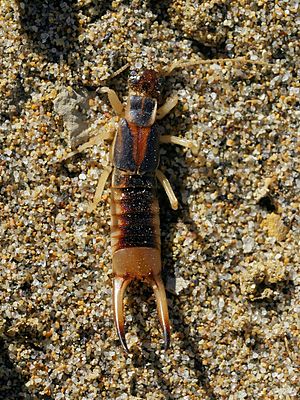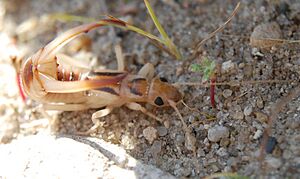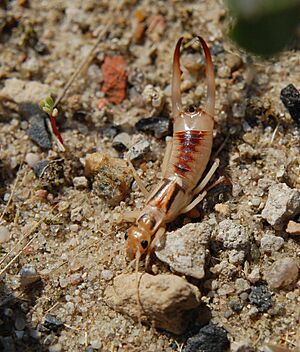Labidura riparia facts for kids
Quick facts for kids Labidura riparia |
|
|---|---|
 |
|
| A Labidura riparia specimen in Ebro Delta, Spain | |
| Scientific classification |
Labidura riparia is a type of earwig that belongs to the family Labiduridae. These earwigs are easy to spot because of their special pincer-like tails, called cerci, and their light tan color. They are often called the shore earwig, tawny earwig, riparian earwig, or striped earwig. This last name comes from the two dark stripes that run down their back.
Sometimes, people mistakenly call them Labidura japonica. However, Labidura japonica is actually a subspecies of Labidura riparia found only in Japan. L. riparia earwigs live all over the world, especially in warm, tropical, and subtropical areas. Their size can vary a lot, from about 16 mm to 30 mm long. They have 10 body segments on their abdomen.
Male and female earwigs have different-sized pincers. Males have much larger and more curved pincers, while females have smaller, straighter ones with a slight curve at the end. Earwigs use these pincers for many things. They help them catch food, defend themselves, choose mates, and even fold their wings.
L. riparia earwigs are known for their complex mothering habits. They are also very good hunters and are often used to control pests. When threatened, these earwigs can release a bad-smelling liquid to scare off predators. People say it smells like something rotting.
Where They Live and What They Eat

The striped earwig likes places that are dark, moist, and have good hiding spots during the day. You can find them in many different environments. They live in both farmed and wild areas, woodlands, and near ponds and lakes. To save energy, these earwigs sometimes use old burrows dug by mole crickets as nests for their young. If their home gets flooded or destroyed, they might fly to find a new one. They are known to fly towards light, as they use the moon to find their way.
L. riparia earwigs are generalist predators, meaning they eat many different things. Their diet mainly consists of insects or dead animals they find. They especially like to eat butterfly larvae and insect eggs. They will eat almost any insect they can find. The earwig can use its long, strong pincers to kill and hold down larger insects. Because they are not picky eaters, they can easily live in many different places as long as there are insects around. If there isn't enough food, they have been known to eat the young or eggs of their own species.
These earwigs are active at night. They only hunt after the sun sets, and they eat most of their food right after dark. Female earwigs can go for a long time without eating when they are getting ready to lay eggs.
The main predators of L. riparia earwigs are ants. Ants often eat earwig eggs that are not being watched. Interestingly, earwigs also eat ant eggs. However, it seems that ants have a bigger impact on earwig numbers than earwigs do on ants. If the number of ants goes down, the number of earwigs usually goes up.
Nesting and Life Cycle

Nests are very important for earwigs. They provide protection from the weather and from predators. Nests are also essential for the survival of their young. Earwigs dig special nests for molting (shedding their skin), feeding, and laying eggs.
The female earwig chooses a good spot, usually under a rock or tree bark, and digs a nest. Female earwigs are the main caregivers for their young. They become protective and will not let males near their brooding chambers. As the female lays her eggs, she carefully picks them up one by one. She cleans them to remove any fungi or dirt. She can lay between 60 and 100 eggs. Once all the eggs are laid, she lies on top of them, much like a hen.
The mother earwig continues to clean the eggs and guard them for about 10 days until they start to hatch. After the young hatch, the mother goes to find food for them. She continues to feed and clean her young until they leave the nest on their own, usually 2 to 5 days later. Each female can do this up to three times in her life, and sometimes even more. Some mothers get lost on their way back to their nest and end up caring for another earwig's eggs, as they cannot tell their own young apart from others.
The young earwigs will then dig their own nests for molting. It can take anywhere from 4 to 50 days for them to reach the next stage of development. They go through a total of 6 stages, called instars, before they become adults. Once they are adults, they live for only about 2 to 3 months and start looking for mates right away. There are usually 2 to 3 generations of earwigs in a year. The last generation of the year will spend the winter underground, in a state of hibernation.
See also
 In Spanish: Labidura riparia para niños
In Spanish: Labidura riparia para niños

